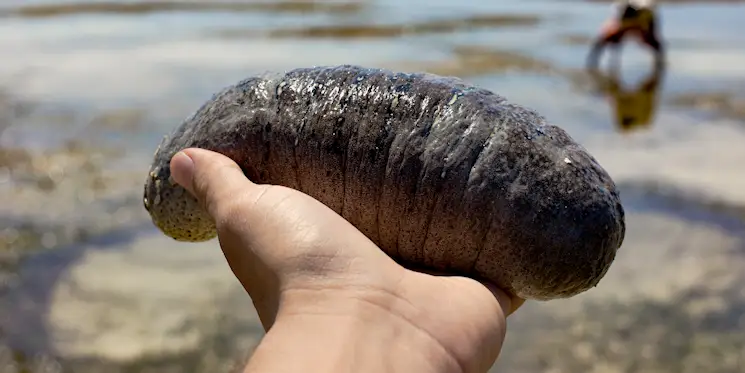Sea cucumbers are vital to healthy coastal ecosystems, according to a study that examined how “sandfish” density relates to the oxygenation of sediments. Researchers recommend that fisheries managers adopt regulations that prevent the overharvesting of important organisms.
It is also a food delicacy in south Asia where its cultivation is a multi-million-dollar industry. The molecules they produce to defend their ecological niche at the bottom of the ocean are highly valued for their medicinal properties.
In a sense, sea cucumbers are the vacuum cleaners of coastal marine environments. Since these invertebrates are also the target of growing demand from Asian markets—dried sea cucumbers are known as “bêche-de-mer”—the authors of the study sought to examine the ecological implications of removing them from tropical coastal areas.

Sea cucumbers have long been used as food and traditional medicine in Asian countries with Stichopus hermanni, Thelenota ananas, Thelenota anax, Holothuria fuccogilva, and Actinopyga mauritiana as most highly-valued species. These organisms are potential source of high value-added compounds with therapeutic properties such as triterpene glycosides, carotenoids, bioactive peptides, vitamins, minerals, fatty acids, collagens, gelatins, chondroitin sulfates, and amino acids.
In recent years, the health benefit effects of sea cucumbers have been validated through scientific research and have shown medicinal value such as wound healing, neuroprotective, antitumor, anticoagulant, antimicrobial, and antioxidant.
 Sea cucumbers are also a good source of magnesium, which helps your heartbeat and bones grow while contributing to the production of healthy DNA.
Sea cucumbers are also a good source of magnesium, which helps your heartbeat and bones grow while contributing to the production of healthy DNA.

Reduced Risk of Cancer
Sea cucumbers are rich in antioxidants and polyphenols (micronutrients from plant-based foods), which have been linked to a reduction in inflammation in the body. This is connected to a lower risk of chronic diseases. In fact, inflammation is linked to a higher risk of cancer, and therefore, consuming dietary polyphenols can help reduce your risk of cancer.
These functional materials lead to potential development in various foods and biomedicine industries. In this review, we have presented a general view of major medicinal and health benefit effects of functional sea cucumbers from the Asia region. The structural significance and the potential application of sea cucumber-derived functional materials as well as their nutritional value are also discussed.
These curious marine animals produce a category of molecule known as triterpenoid saponins which are widespread in plants, but rare in animals.
Until now the question of how they evolved their unusual ability to produce these molecules has been unexplained.
An international research collaboration investigated the genome of sea cucumbers and compared them with the genomes of other Echinoderms, such as sea stars and sea urchins.

In sea cucumbers this sterol-producing function had been diverted to produce two new genes in this enzyme family. Using molecular biology, the researchers isolated the genes, transferred them to yeast and analysed the extracts.
This showed that the genes have acquired new functions; one of them makes an alternative type of saponin that the sea cucumber uses for self-defence, and the other produces molecules that protect the creature from the toxic effects of its own chemicals.

Chemical analysis showed that these genes, required for the synthesis of self-defence compounds were expressed more in the outside layers of tissue.
The next stage for this research is to find the remaining chemical steps necessary to make these potentially high-value chemicals so that they can be produced using plants or yeast more cheaply and help conserve sea cucumbers in their natural habitats.
Saponins are widespread natural products, with more than 20,000 reported. They have a wide range of uses, traditionally as a source of soap and more recently as vaccine adjuvants, foaming agents, antifungal treatments, and emulsifiers.
Many animals use toxins as chemical defences – usually obtained from food or produced via symbiotic relationships. Echinoderms, in contrast, biosynthesise their toxins themselves.

Professor Anne Osbourn, a group leader at the John Innes Centre, and corresponding author of the study said, “sea cucumbers are massively important in Asia as a health benefiting food source and for traditional medicines.
So, if we can understand how their molecules are made we can make these high-value compounds without needing to grind up sea cucumbers. We can make them using plants or yeast.”














